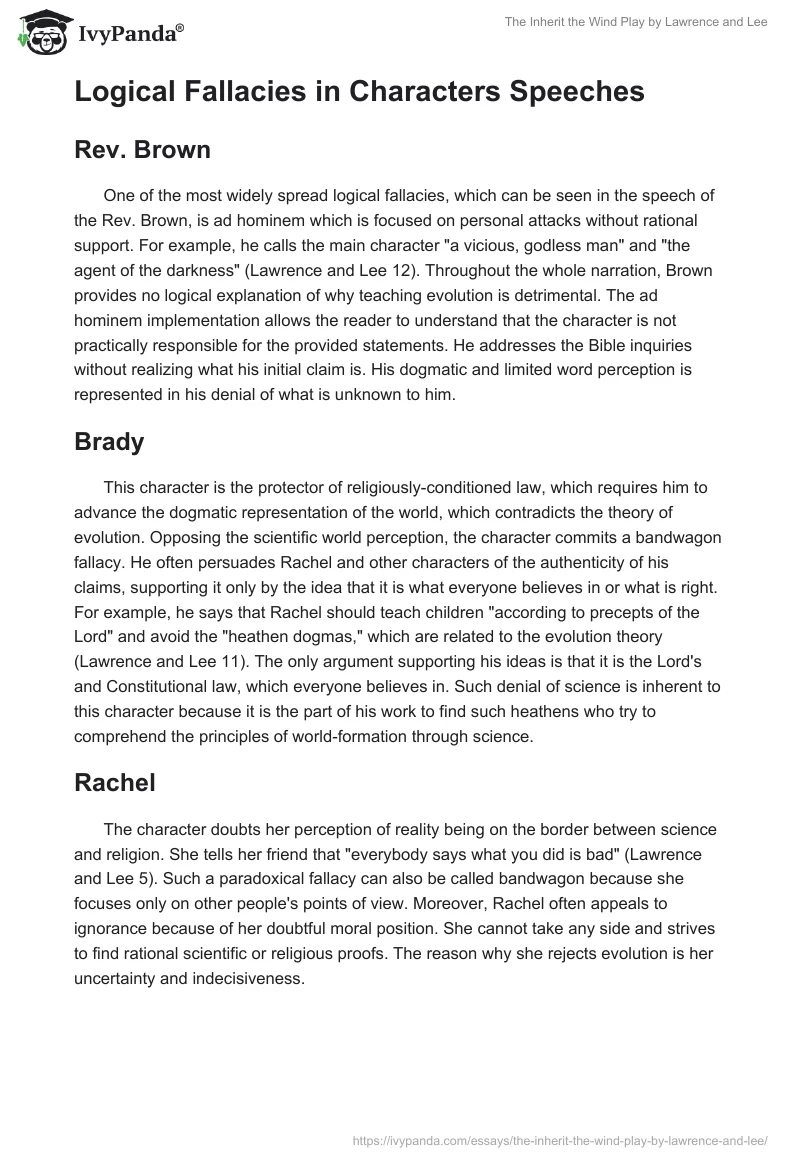Introduction
The play Inherit the Wind, written by Jerome Lawrence and Robert Lee, touches upon the contradiction of science and religion, limiting the freedom of thought. The story fictionalizes a real-life trial related to teaching the evolution theory. The interactions and inconsistencies in faith and science are the apparent problems that occur due to differentiated perspectives on the world’s development. The correlation between science and religion itself contains a logical paradox. Developing the characters’ personalities within the scope of the trial, Lawrence and Lee state that despite having the exact cause of seeking the truth, religion and science are different. The characters’ judgments and reasoning contain logical fallacies, which lead them to misinterpret science.
Doubting Science
Based on the offered for the analysis essay, the significant reason for doubting scientific inquiries correlates with intuitive world perception. The human psyche fails to recognize the scientific data contradicting the intuitional perception. As a result, the fear of the unknown supported by the contradiction of the perception and scientific truth occurs. Religion is more advantageous in this case because it evolves the supernatural powers which describe notions that are impossible to comprehend by people’s minds. Based on such emotions, people often feel offended by the science commuting the logical fallacies in their reasoning. Inherit the Wind represents such lost people through the images of Rev. Brown, Brady, and Rachel, who oppose evolution in favor of religion.
Logical Fallacies in Characters Speeches
Rev. Brown
One of the most widely spread logical fallacies, which can be seen in the speech of the Rev. Brown, is ad hominem which is focused on personal attacks without rational support. For example, he calls the main character “a vicious, godless man” and “the agent of the darkness” (Lawrence and Lee 12). Throughout the whole narration, Brown provides no logical explanation of why teaching evolution is detrimental. The ad hominem implementation allows the reader to understand that the character is not practically responsible for the provided statements. He addresses the Bible inquiries without realizing what his initial claim is. His dogmatic and limited word perception is represented in his denial of what is unknown to him.
Brady
This character is the protector of religiously-conditioned law, which requires him to advance the dogmatic representation of the world, which contradicts the theory of evolution. Opposing the scientific world perception, the character commits a bandwagon fallacy. He often persuades Rachel and other characters of the authenticity of his claims, supporting it only by the idea that it is what everyone believes in or what is right. For example, he says that Rachel should teach children “according to precepts of the Lord” and avoid the “heathen dogmas,” which are related to the evolution theory (Lawrence and Lee 11). The only argument supporting his ideas is that it is the Lord’s and Constitutional law, which everyone believes in. Such denial of science is inherent to this character because it is the part of his work to find such heathens who try to comprehend the principles of world-formation through science.
Rachel
The character doubts her perception of reality being on the border between science and religion. She tells her friend that “everybody says what you did is bad” (Lawrence and Lee 5). Such a paradoxical fallacy can also be called bandwagon because she focuses only on other people’s points of view. Moreover, Rachel often appeals to ignorance because of her doubtful moral position. She cannot take any side and strives to find rational scientific or religious proofs. The reason why she rejects evolution is her uncertainty and indecisiveness.
Conclusion
Therefore, there is a direct correlation between the psychology of the characters and the reasons why they reject evolution theory and science. Their speech’s logical fallacies prove they are afraid of what seems unexplored. Intuition is directly connected with the formation of world perception and psychology. It is challenging for the characters to accept what seems new and unfamiliar. They focus on traditional values established within society being afraid of changes. Therefore, logical fallacies help to analyze the reasons for science rejection.
Work Cited
Lawrence, Jerome and Lee, Robert. Inherit the Wind. Ballantine Books, 2007.


